
Welcome to Trash Panda City

work as if you live in the early days of a better nation

Slides from last night’s talk:
It’s impossible to have a Raspberry Pi Zero overheat unless you overclock it. That’s why you don’t get any cases for it with fans or heat sinks. The quad-core Raspberry Pi Zero 2 W, though, has the potential to do so. Here are some numbers:





Unless you’re doing things that might indicate you should be using a bigger computer, a Raspberry Pi Zero 2 W won’t overheat and doesn’t need any form of cooling. If you’re overclocking, well … it’s your choice to have cooling equipment worth more than the computer it’s trying to cool.
This guy sets up on the SE corner of Yonge & St Clair most afternoons, and plays endless variations on the above recording. He’s playing an autoharp with the chord bars removed, and run through a homebrew battery-powered amplifier with much reverb and distortion. A bunch of the burbly noises are 8kbit/s voice recorder artifacts from my phone.
Although the themes seem repetitive, I don’t think they repeat exactly every time. He seems to be in a happy place playing them.
Update: now posted on the Friends of Wind Blog: Windshare: A stellar investment, a gallant icon.
I’ve never regretted my investment in WindShare. When I heard about the plan to put a wind turbine at Exhibition Place, I’d been in Canada for less than a month. We didn’t even have a permanent place to live when I put down my $501. I knew, though, that it would be an investment in the future.
Five hundred bucks seemed quite a bit of cash back then, but these days, it’s less than a flight to anywhere. It’s less than a weekend mini-break. It’s a couple of month’s car insurance, or worse, a car maintenance bill which I wouldn’t even grumble over now. No-one ever expects a car to appreciate after you’ve had the shocks redone, so in the same way, I don’t feel bad about my investment in WindShare not having a financial return. It’s had a much more rewarding return than mere money.
Sure, the initial offering indicated that we were supposed to make a reasonable return, what with the deregulation of the Ontario energy market. You don’t remember that? When the Conservative Ernie “Odo†Eves administration deregulated the market back then, you may have blinked and missed it. At the first taste of $100 power, the deregulation was cancelled, because market forces must always take second place in this province to re-electability. Poor Ernie; we almost saw his like again …
WindShare was supposed to have at least two wind turbines, which would have helped the return to members. For $REASONS, the other one didn’t happen: bureaucracy, lack of suitable turbines, fun with the TPA, lack of headroom from the island airport; any/all/some/none of the above can be cited. We were also supposed to export the model to a community-owned wind farm, but that didn’t happen. The province decided that any and all transmission and distribution near the Bruce was off-limits to all but the eponymous power company. So it goes.
Because of my wind power experience in the UK, I handily got on the inaugural board of WindShare. We campaigned for members around the city. We spoke to anyone who wanted to listen. We built the thing because we believed in the statement we were making. We didn’t hide our pride: we put the turbine where it would be seen by millions every day. If we could’ve put it on the lawn at Queen’s Park, we would.
We even sourced as much of the turbine locally as we could. The tower was made in Ajax. The blades were made in Huron Park. If there had been FIT Domestic Content rules back then, we would’ve aced them.
Now, not quite everything went swimmingly. A few weeks after construction, our vendor went bankrupt. A robust service agreement with a vendor is key to a wind project’s success. With the incredible support of WindShare’s partner in the turbine, frequent visits from the former service tech, a great local electrical service company, and hours and hours of work from dedicated volunteer members, we kept the turbine spinning. Try that with a nuclear plant. Actually, on second thoughts, please don’t.
We also had a slightly smaller set of blades than we’d ordered, having been promised longer ones by the now-defunct vendor. This meant we had to derate the turbine a bit more to avoid challenging operational conditions. Every year at CNE time, we’d lose comms to the turbine as one of the carny trucks would inevitably take out the overhead phone line. We fixed that one.
Other problems cropped up, too. The inverter would get a bit warm in summer heat, and go for a siesta. After building an effective cooling system, the inverter chugged along for a few years until it needed to be replaced. It was interesting working in Canadian generation back then; run-of-the-mill European power electronics were seen as weird new-fangled voodoo in Ontario. As we have lots of wind and solar now, IGBTs are no longer a source of IDKs.
Our wind resource wasn’t quite where we thought it might be, either. ExPlace has a lovely clear fetch across the lake, and historical data from the island might’ve indicated that. Who knew that most of the wind would seem to come over from the city, fuelled by the urban heat effect, and turbulent as all-get-out from chasing through the buildings? Well, we do. With ten year’s hindsight and operational data, that is.
So this turbine — little, (sometimes) broken but still good — what did it start? Well, it lead to the idea of community sustainable power in Ontario. It lead to the abolition of coal power in the province (which, if you can remember the acrid yellow goo that passed for air downwind of Lakeview, you’ll appreciate). It lead to the world-leading FIT program, driving the development of Ontario’s wind and solar industries, which as the last election shows have the overwhelming support of the people of Ontario. It also lead, on a personal scale, to my last decade’s employment building this Province’s sustainable energy base.
So when I see the WindShare turbine — whether fleetingly, from a GO train, or at extreme length when stuck on the terminally gridlocked Gardiner Expressway — it still makes me smile. We built an icon. We built careers then unknown to the province. We built hope. And from that, the return on satisfaction is better than any deal you can get on Bay St.
On Wednesday, Catherine and I went to Ripley’s Aquarium of Canada. It was fantastic. I took some pictures:
Uhoh. Wonder Pens sells pens — neato pens — and they are in Toronto. The Platinum Preppy they sent me free with my first order writes better than any $4 fountain pen should.
That’s the rapid clatter of chopping up Kothu Roti at Amma at the end of our street. You know that tasty spicy food is imminent when you hear that sound. I’m really pleased that Amma’s back under the original management. The other proprietors just didn’t care as much about their food.
Very little urban hum this morning (holiday), and the air conditioners really hadn’t started yet, so please be amused by the sounds of the garden (featuring mostly mockingbird): about quarter to nine. It does a passable seagull and also a red-tailed hawk. The vehicle reversing sound, though, is real.
(at least I don’t have a mockingbird problem.)
Toronto Hydro’s just announced peaksaver PLUS, where you get a free Blueline Power Cost Monitor. Dammit! If only I hadn’t already bought one …
(and no, I haven’t yet got the Arduino wireless monitor running, which was actually the whole reason I got into ham radio.)
I have had a nice BASIL basket on the back of my bike:
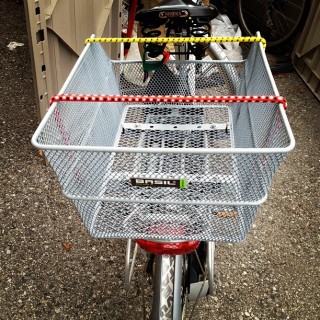 With that, it has
With that, it has had all three of Syd’s requirements. But there’s a problem; with the basket on, it doesn’t fit into my bike locker:
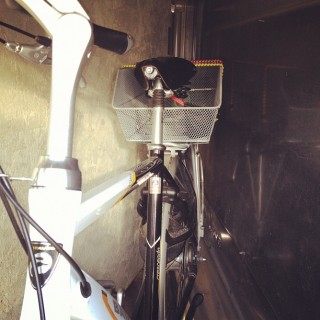 These Cycle-Safe lockers taper down to a narrow point, so basically anything other than a stripped-down bike won’t fit. The city says of the lockers:
These Cycle-Safe lockers taper down to a narrow point, so basically anything other than a stripped-down bike won’t fit. The city says of the lockers:
“Most standard bicycles will fit insideâ€? Grah. If there’s something more standard that a Dutch bike with a basket on the back, I don’t know what it is. I have to go back to my makeshift solution — a too-tall basket lashed on with bungees — and deal with it biting my bum as I ride. Sigh.
As seen in Birkdale Ravine: wind and solar powered LED lighting in an area with heavy tree shading. Not just any wind turbines, VAWTs, no less. In the words of Modern Toss’s Drive by Abuser, “How’s that working out for you, yeah?”
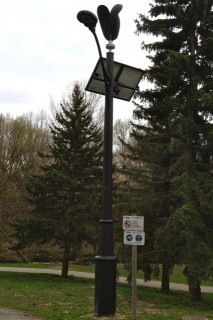
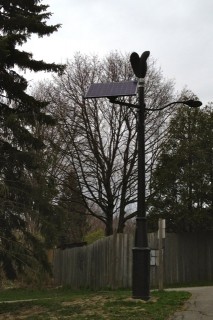
City Hall is currently tearing itself apart over transit. You’d think that in a city with a downtown that’s pretty much gridlocked for three hours of the day, the answer to the transit question would be “More please everywhere”, but in this precious city, it’s less than that.
We have a mayor who is obsessed with subways because he thinks they’re fast and will keep the automobiles running. Unfortunately, Toronto is a big sprawly city with less than infinite cash, so we’re not going to get subways everywhere. Our last venture into subway building — the Sheppard line — has been a bit rubbish, running a stubby distance to nowhere in particular, and being quiet enough that you can always get a seat.
Though I live in Toronto, I’m originally from Glasgow. Glasgow has a subway; in fact, it’s one of the world’s oldest. It was opened in 1896, when Glasgow was at the height of its “Second City” fame. Glasgow made the ships and trains that maintained the empire, and trained the engineers of the world. We were pretty hot shit at the time, and we had a bunch of workers we needed to get around every day from the shipyards and offices of the city. Lots of people moving in to work. Ergo, subway!
Just one problem: cities change, subways don’t. Even though shipbuilding was never a hugely lucrative industry (according to my grandfather, who worked at John Brown’s, they never cleared more than 7% even at the best times), Glasgow and environs would probably have never thought that its industries would change and contract the way they did.
So what’s the subway that Glasgow’s been left with?
Glasgow used to have quite an extensive tram network. Of course, you wouldn’t know now, ‘cos it’s all been ripped up, but you can do that with street-level transit. Subways you’re stuck with.
Cities and cultures never know when they’re at their height. Glasgow had it going on when it built its subway, yet I’m sure the city planners never thought that the city would change the way it did. At least Glasgow made stuff that everyone needed; Toronto, what do you do that keeps you anchored here?
Black Walls’ new album Acedia is available for pre-release purchase.
 I’ve had Ken’s artwork on my wall as a huge print for the last couple of years. I’m stoked that this is now out.
I’ve had Ken’s artwork on my wall as a huge print for the last couple of years. I’m stoked that this is now out.
I’d seen that the city had been working on the path over the train tracks at Lord Roberts Wood, but hadn’t seen the completed project. What was formerly a real slog to lift a bike (and especially a sensible bike) up these steps now can be ridden without dismounting. Yay Toronto!
(apologies for picture quality. My Blackberry is in perma soft-focus)
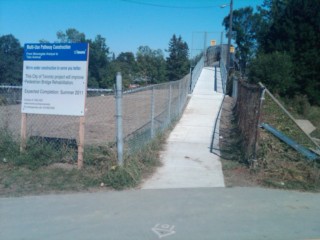
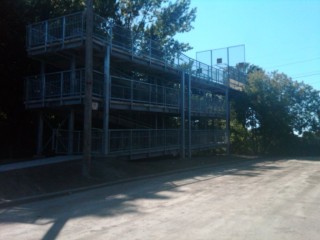 If you want to see how they looked last year, there are some automatic photos from my Canada Day post: sd790-20100701-161516, sd790-20100701-161535, and sd790-20100701-161614. A great improvement has been made.
If you want to see how they looked last year, there are some automatic photos from my Canada Day post: sd790-20100701-161516, sd790-20100701-161535, and sd790-20100701-161614. A great improvement has been made.
If I must kvetch (and I must: cyclo, ergo kvetch), the turns in the ramp are just a little too narrow to navigate a bike round. I can make most of them if I crawl round it, but I usually have to dab a foot down.
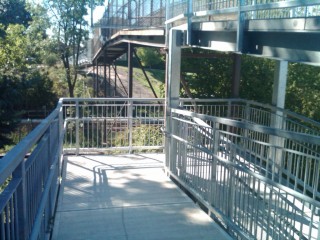 There’s also no lighting. I’m not sure how welcoming this facility would be to use at night. Also, some of the handrails look as if they should either be welded or bolted in place, but are neither. Some have half-hearted tack welds, but they look as if they were done straight onto the zinc galvanizing so were destined to end badly.
There’s also no lighting. I’m not sure how welcoming this facility would be to use at night. Also, some of the handrails look as if they should either be welded or bolted in place, but are neither. Some have half-hearted tack welds, but they look as if they were done straight onto the zinc galvanizing so were destined to end badly.
MetaFilter‘s Ownâ„¢ TimTypeZed — aka Tim Shortt — is incredibly modest about his talents in person, but his artwork speaks for itself:

Tim’s my nearest neighbour on MetaFilter, and I’ve met him at a couple of meetups.